Hayflick’s limitation and skin rejuvenation – Is there a concern?
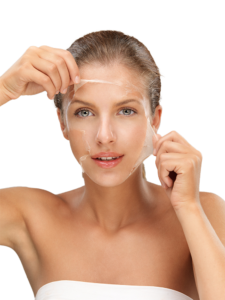
Every now and then, a new trend emerges in the world of cosmetics. Some trends are based on science, constitute innovation and even a kind of breakthrough in the aesthetic treatment of the skin. Another part, stems from less tested and established information.
Recently, I was asked by a large group of beauticians in Hungary, about a topic that is not new at all, but that nevertheless came up. It’s called: Hayflick’s limit.” They heard during professional product training that performing peels with hydroxy acids, may at some stage cause the skin to simply “run out” or be very thin and sensitive, with no further ability to regenerate. This is because the use of hydroxy acids accelerates cell divisions, and cells have a finite number of divisions that have been “dictated” to them in advance at the DNA level.
This is the article I wrote on the subject, which was published in Beauty & Care magazine
In 1961, Leonard Hayflick published his findings, based on cells from a lung source grown in a Petri dish, according to which cells can divide a limited number of times – about 50 on average.
His findings were accepted at the time as a breakthrough despite two main problems:
- Cells that grow in a dish are not an indication of the behavior of that type of cells in the living body. In living things, cells react to a variety of factors, signals, hormones, and biological substances around them in a way that creates a big difference between what you see in the lab and what happens in the living body.
- There is a great difference, in terms of the number of divisions, between different types of cells in the body. There are tissues with a slow turnover of cells, and other tissues – such as mucous tissues, the bone marrow that regularly produces blood cells of various types, the epithelial cells that line the intestine and make up the epidermis – tissues with a high rate of cell turnover and constant regeneration. In these tissues the cells are equipped with mechanisms for preserving and extending the ability to divide.
Many studies, which were conducted later to understand in depth the limit of the ability of cells to divide, showed that the two limitations mentioned above, place question marks and exceptions on the “rule” of the 50 divisions.
Indeed, in every division of a cell into two, there is a shortening of the telomeres. A telomere is a special structure at the ends of the chromosome. It is actually DNA, which contains repetitive sequences that do not code for genes. The telomers protects it from wear and tear and threats from the cellular and extracellular environment. Prior to each division of a cell there is a doubling of the genetic material, for subsequent division into two. After division, the telomeres are slightly shorter. A cell whose telomeres have shortened significantly has actually reached the end of its life cycle. In this situation, there are cases that the cell performs apoptosis, although not allways. Damage to telomeres happens, by the way, for a variety of reasons that are not related to age or the number of divisions the cell has made: UV damage, free radicals, certain chemicals.
Cancer cells can “live forever”. They have a mechanism that is responsible for this. The mechanism is based on the enzyme telomerase, which lengthens the telomeres after each division.
Stem cells – those cells that have not finally differentiated into a specific cell type – can also divide over 1000 times (which could have been enough for us to live over 150 thousand years). They also have telomerase.
When we ask whether the continuous performance of the peeling procedure shortens the lifespan of the epithelial cells (epidermis), we must know some facts.
- Clinical studies have revealed that in the epidermal cells (as well as in the epithelial cells in the tongue) we have telomerase activity. That is, the Hayflick limit and the division quantities published by him, are not valid for this type of cells. This makes sense, given the fact that epithelial cells divide a large number of times and need to maintain this ability to divide all the years of the living being’s life. It must be remembered that even a 100-year-old person, if cut – the wound will heal and close, which shows that the production capacity of new cells is preserved. In general, in living things, functions that are necessary for survival are preserved throughout life.
- We find support for the body reacting to environmental threats in a comparison made between epidermal samples from areas that were exposed to the sun and areas that were protected from the sun. In both samples there is telomerase activity, but higher activity – in areas exposed to the sun. That is, our skin has repair mechanisms and coping with environmental threats that are activated as needed. Source:
https://www.sciencedirect.com/science/article/pii/S0022202X15300506
- A clinical study from 2002, on different cell types, found telomerase activity in a variety of dividing cells such as fibroblasts, epithelial cells and even cardiac muscle cells, and concluded that “it now seems likely that telomerase is active in vivo where and when it is needed to maintain the integrity of the tissue”. Link to the study:
https://pubmed.ncbi.nlm.nih.gov/12089551/
- If that’s not enough, let’s remember that we have stem cells in our skin that are designed to restore and replace cells when needed and in response to environmental threats.
- Since long after the publication of Hayflick’s limit theory, more specific and extensive studies on the subject were published, which include the extraction of tissue samples from living creatures, we can now also talk about the “numbers”. Well, epidermal cells shorten each year of life by about 36bp on average. The term bp refers to “base pairs” – these are actually the building blocks of the telomere (and of DNA in general). In humans, the length of the telomere is 7000-10,000 bases (there is great variation between people) and there are other reports of 13,600 or more. Even in multi-dividing cells , we will have more than 150 years of life with dividing skin cells, even before telomerase has to be activated and extend the chromosome ends.
- It was found that the rates of telomere shortening in cells growing in a petri dish are higher than the shortening of telomeres in the living body. This is another proof of telomerase activity, or alternatively that a branched and complex network of signals and reactions operates in our body, which do not happen in cell culture in the laboratory.
- Fibroblasts from 100-year-old people were tested and found to have an average telomere length of 67,000 bases, a figure that allows for about 20 additional doublings.
By the way, the activity of telomeres and telomerase, which were discovered years after the publication of Hayflick’s first book, received a very brief and partial mention in the second edition of his book. As well as other processes that can explain the effect of external factors on disrupting the ability of cells to divide and reaching a state of apoptosis. (For example: radiation, chemicals, over-oxidation from free radicals, violent viruses and more). Hayflick did not address in depth the lengthening of telomeres using the telomerase enzyme.
Today scientists know that despite the great interest raised by Hayflick’s research, one should not conclude from them that telomeres and telomerase hold the exclusive key to the fountain of youth. In fact, nerve and muscle cells also die, even though they do not divide. On the other hand, mice have longer telomeres than humans and yet they only live three years. Flies continue to function well even when their telomeres run out. In fact, Hayflick also does not support the view that we age or die because our cells have exhausted their possible number of divisions. And he even presented, for evidence, the fact that cells of very old people can multiply themselves several more times.
Science recognizes that aging is not the result of a single biological mechanism, and the puzzle of aging remains the same even today.
Peeling wigh hydroxy acids
The use of hydroxy acids improves many functions of the skin, at all ages and for a variety of purposes. Decades of research document the importance of removing dead cells and helping to increase the rate of metabolism in mature skin. But it is used for a variety of purposes at a variety of ages, regardless of the renewal of mature skin.
Here are some of the indications for which hydroxy acids are used,
Indications backed by hundreds of studies:
- Treatment of skin prone to comedones – at all ages. Hydroxy acids help normalize skin cell turnover and the desquamation of keratinocytes, as well as remove dead skin cells that have accumulated in the pore and created comedones. The treatment of comedones through drainage, without the involvement of hydroxy acids, will lead to the need for chronic visits to the cosmetic clinic for drainage, without addressing the root of the problem. And on the other hand – a patient with comedonics, who simultaneously uses hydroxy acids, his skin will later produce fewer and fewer new comedones, and at the same time the drainage will be less traumatic and painful.
- Various problems of hyperkeratinization (such as seborrhea and more) as well as the formation of keratinization under the influence of exposure to the sun, are effectively treated with hydroxy acids.
- In mature skin, the rate of cell division becomes slower than normal. Dead cells accumulate on the surface of the skin and give it a dull and lackluster appearance. There is no way to remove them other than using hydroxy acids or retinoids, or some other way of peeling. The concentration of the acids and the frequency of use can be moderate, without irritation or damage to the skin, and still result in smoother and brighter skin.
- Dead cells that have accumulated and not been peeled off from the epidermis, result in a further slowdown in skin metabolism and an even slower rate of cell division. This negatively changes the composition of the skin and the function of the epidermal barrier and to a decrease in the level of moisture in the skin. It is known that hydroxy acids help speed up metabolism, which ends in building a healthier and more functional epidermal barrier, which preserves moisture.
- Hydroxy acids, by themselves, both increase moisture (they have a hygroscopic property) and are also antioxidants.
- At low concentration, hydroxy acids are also anti-inflammatory.
- Hydroxy acids increase the level of hyaluronic acid in the skin – which is a contribution to the moisture, elasticity and function of the epidermis.
- The lactic acid, specifically, has been documented to further increase skin moisture being part of the NMF component as well as being anti-inflammatory and balancing the natural flora.
- Hydroxy acids help treat skin pigmentation. As you know, the ultimate treatment for hyperpigmentation (along with ingredients that suppress melanin production) is skin peeling. Continuous use of them results in an even skin tone and prevents the accumulation of skin spots.
- The hydroxy acids increase the rate of metabolism in the skin so that all the functions of the skin become more similar to the functions of younger skin, the composition of the substances and the function of the epidermal tissue remain healthy. Peeling is much more than an external contribution to an aesthetic appearance. It is important for the healthy functioning of the skin.
- Hydroxy acids help in the treatment of open pores – a problem that affects the aesthetics of the skin and can only be effectively solved using retinoids or hydroxy acids. By the way retinoids, they also increase cell divisions and lead to peeling. (Is the company that made those claims also against retinoids?)
It is important to remember that:
- Ingredients that harm the skin in the short and long term – are prohibited or alternatively their concentration is limited by the health authorities – the FDA, the CE, etc. Indeed, hydroxy acids in the concentration allowed by the health authorities are an ingredient that contributes to the near and far term, unlike concentrations that are prohibited and can lead to irritation, sensitivity to sunlight, etc. The health authorities constantly monitor the ingredients that are applied to the skin and take care of the consumer’s well-being.
- Literature reviews conducted to examine the question of whether the hydroxy acids are “foe or friend” presented studies with conflicting results (some of them showed a tendency to burns or irritations, some of them showed skin rejuvenation, improvement in the function of skin cells, firming of the skin, increase in moisture and more) and concluded that The answer is: “it depends”. The answer depends on the nature of the acid, its concentration, the PH of the preparation, the manner and frequency of use. Acids are not “good” or “bad” for the skin, they are a tool that when used correctly can contribute, and when used incorrectly (or at a high concentration / low PH) can cause side effects. But isn’t that true of many other cosmetic ingredients?
- By the way, none of the studies that showed side effects in the use of high-concentration hydroxy acids dealt with Hayflick’s limitation or mentioned it.
In the 18 years of experience that Biofor has with the use of hydroxy acids, retinol and other peeling ingredients, we have refined the correct concentrations and protocols according to the goals, the skin tones and the different skin conditions. The products were developed in accordance with knowledge based on science (see below a partial list of articles) and were mainly refined over the years while in close contact with the field – the experience of beauticians and the feedback we received over the years and still receive from treating hundreds of thousands of patients.
We also see, thanks to the close relationship with the professionals and the consultations in professional forums of Biofor, what the skins of women who have never been treated with acids or retinol look like. See below some examples of untreated skin at various ages. We also see the condition of mature skin that has been treated over the years with hydroxy acids. This is smoother, radiant skin, with an even tone, a youthful appearance for its age and healthy function. Even if it is characterized by wrinkles or sagging, the texture is still healthy and beautiful.
If we leave the skin to “age naturally” and leave the metabolic rate slow as happens over time to mature skin that has not been exfoliated, we will see:
- A dull and lustrous appearance, lacking vitality.
- A yellowish/grayish tone instead of a vital and radiant look.
- The low metabolic rate of the skin cells will impair the function of the epidermal barrier, which can be harmful in many ways.
- One of the damages is a decrease in the ability of the epidermal barrier to retain moisture. Another damage is skin vulnerable to infections and penetration of unwanted substances into the skin.
- Skin that has not been treated with peeling is characterized by the accumulation of uneven pigmentation and skin imperfections.
Untreated skin – examples:
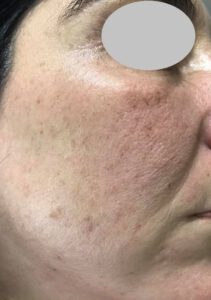
43 years old
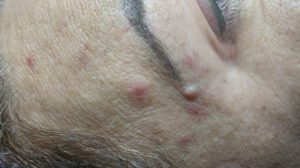
58 years old
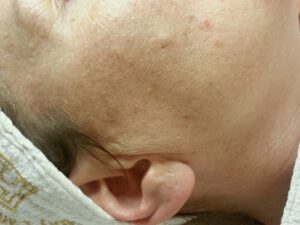
55 years old
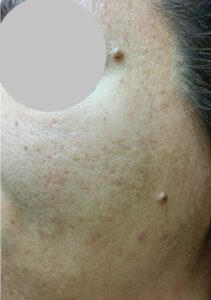
40 years old
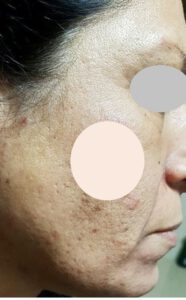
43 years old
Bibliography
- Sheau-Chung Tang, Jen-Hung Yang .Dual Effects of Alpha-Hydroxy Acids on the Skin.
Molecules 2018, 23(4), 863; https://doi.org/10.3390/molecules23040863
- Philipp Babilas, Ulrich Knie, Christoph Abels. Cosmetic and dermatologic use of alpha hydroxy acids. Journal of German Society of Dermatology, 2012, https://onlinelibrary.wiley.com/doi/10.1111/j.1610-0387.2012.07939.x
- Șoimița Emiliana Măgerușan, Gabriel Hancu, Aura Rusu. A Comprehensive Bibliographic Review Concerning the Efficacy of Organic Acids for Chemical Peels Treating Acne Vulgaris Molecules 2023, 28(20). https://doi.org/10.3390/molecules28207219
- Tang, S.C.; Yeh, J.I.; Hung, S.J.; Hsiao, Y.P.; Liu, F.T.; Yang, J.H. Glycolic Acid Silences Inflammasome Complex Genes, NLRC4 and ASC, by Inducing DNA Methylation in HaCaT Cells. DNA Cell Biol.2016, 35, 124–134. https://pubmed.ncbi.nlm.nih.gov/26784358/
- Tang, S.C.; Liao, P.Y.; Hung, S.J.; Ge, J.S.; Chen, S.M.; Lai, J.C.; Hsiao, Y.P.; Yang, J.H. Topical application of glycolic acid suppresses the UVB induced IL-6, IL-8, MCP-1 and COX-2 inflammation by modulating NF-kappaB signaling pathway in keratinocytes and mice skin. Dermatol. Sci.2017, 86, 238–248
- Gupta, R.R.; Mahajan, B.B.; Garg, G. Chemical peeling—Evaluation of glycolic acid in varying concentrations and time intervals.Indian J. Dermatol. Venereol. Leprol. 2001, 67, 28–29.
- Ai, C.; Ma, N.; Zhang, Q.; Wang, G.; Liu, X.; Tian, F.; Chen, P.; Chen, W. Immunomodulatory Effects of Different Lactic Acid Bacteria on Allergic Response and Its Relationship with In Vitro Properties. PLoS ONE2016, 11, e0164697
